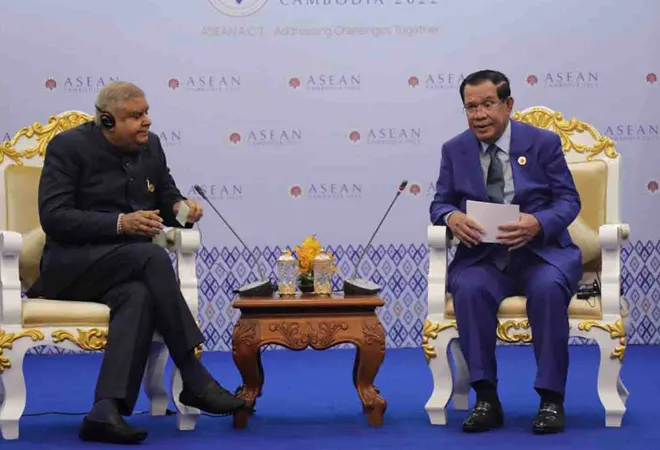
In the ever-evolving geopolitics of the Indo-Pacific region, India’s progressing relationship with the Association of Southeast Asian Nations (ASEAN) seems vital. This year marks the 30
th year of ASEAN-India relations and has been designated the
“ASEAN–India friendship year” by the Indian Prime Minister Shri Narendra Modi while India seeks to advance its cooperation with significant Southeast Asian countries.
Several recent developments have directed this course. The
strategic military and naval engagements with Indonesia and Vietnam accompanied by preparations for the sale of the
BrahMos cruise missile to the Philippines have signalled India’s aim to strengthen its strategic cooperation with these nations.
The mine clearance cooperation with the Indian government was particularly emphasised in this visit. India, in June 2022, signed a Memorandum of Understanding (MoU) on funding a mine-free village project in Koh Kong province that intends to help 8,000 people inhabiting this region.
From 11-13 November 2022, the Vice-President of India, Shri Jagdeep Dhankhar, accompanied by External Affairs Minister, Dr S. Jaishankar, led the Indian delegation to Cambodia on a three-day visit to attend the ASEAN-India Commemorative Summit and the 17
th East Asia Summit. On the sidelines of the summit, India prepared to expand its relations with Cambodia as they celebrate the 70
th anniversary of their bilateral relations this year.
With this focus, the Indian Vice President met with Prime Minister Hun Sen and discussed different issues pertaining to the advancement of bilateral relations. The
mine clearance cooperation with the Indian government was particularly emphasised in this visit. India, in June 2022, signed a Memorandum of Understanding (MoU) on funding a mine-free village project in Koh Kong province that intends to help 8,000 people inhabiting this region. Victim assistance is also being extended by providing prosthetic limbs to those affected by mine accidents. In this regard, two health centres that fall under the “Jaipur Foot” prosthetics programme are being considered to be established in the near future.
Incidentally,
four MoUs were inked during this visit. The first is in the field of health and medicine. The second MoU was signed for the reintroduction of tigers in Cambodia, which have become extinct due to poaching and habitat loss. In this regard, there will be capacity building for a tiger ecosystem followed by the handover of tigers. The third MoU was signed between the Indian Institute of Technology, Jodhpur, and the Institute of Technology, Cambodia to increase collaboration in the field of education and digital conservation of cultural heritage. The last MoU was signed on the Financing Agreement on Conservation and Preservation of Ramayana-based murals in Wat Raja Bo Pagoda in Siem Reap, Cambodia.
India has since played an important part in the restoration of temples like the famous Angkor Wat temple in Cambodia, which has been appreciated by the Cambodian people and government.
Advancing bilateral relations
Indian diplomatic ties with Cambodia
were established in 1952. Ties between the two nations were disrupted after the Khmer Rouge regime infamously known as the genocidal regime (since the leaders killed
around 1.7 to 2 million Cambodians) took control in 1975. However, New Delhi was the sole nation to recognise Cambodia after the fall of the Khmer Rouge regime in 1979. An embassy in Phnom Penh
was revived in 1981.
New Delhi has been one of the signatories of the 1991 Paris Peace Agreement that was instrumental in the culmination of the warfare in Cambodia.
India has since played an important part in the restoration of temples like the famous Angkor Wat temple in Cambodia, which has been appreciated by the Cambodian people and government. The
restoration of another temple complex at Ta Prohm has been a major ongoing project. India completed two phases of restoration, and the third phase, which began in 2016, is expected to be completed in 2026. The
Hall of Dancers, a section at Ta Prohm, was inaugurated by Shri Dhankhar during this visit.
Considerable development support through programmes such as the
Indian Technical and Economic Cooperation (ITEC) and Mekong Ganga Cooperation (MGC) projects is also being provided to Phnom Penh. India is also providing central assistance for
Quick Impact projects that focus on the development of the nation.
In June this year, as part of the 70th-year celebration of bilateral ties between India and Cambodia, a
logo was unveiled in the presence of Deputy Prime Minister Prak Sokhonn, Minister of Foreign Affairs and International Cooperation, and Dr Rajkumar Ranjan Singh, Minister of State of External Affairs, Government of India. The
8th International Yoga Day celebration was also celebrated in June 2022 with more than 500 people, including dignitaries, participating in it. To highlight the linkages between Sanskrit and the Khmer language, the Embassy of India organised
Sanskrit Day celebrations in August 2022 with the participation of eminent Sanskrit scholars of Cambodia as well as Indian and Cambodian artists.
Considerable development support through programmes such as the Indian Technical and Economic Cooperation (ITEC) and Mekong Ganga Cooperation (MGC) projects is also being provided to Phnom Penh.
Moreover, the Indian Chamber of Commerce in Cambodia will be conducting the
Business Excellence Program Awards 2022 in the second week of December 2022 in Phnom Penh, with an aim to promote business- and investment-related activities for boosting trade and commerce between the two nations. More than 200 companies, both private and public, are expected to participate from both nations.
However, trade between India and Cambodia remains inadequate. As per the 2021 report, the total trade volume between
Cambodia and India amounted to US $311 million. India is among the top 10 foreign investors in Cambodia and the fourth largest trading partner in ASEAN with bilateral trade in
2019-20 worth US $86.9 billion. Cambodia is also in plans to establish a bilateral Free Trade Agreement (FTA) with India It already has FTA with China, South Korea and Japan. Analysts believe that this will benefit Cambodia since India has a thriving economy and technology sector.
Cambodia also appreciates India’s role in supplying COVID-19 vaccines, most recently under
the QUAD vaccine initiative.
With respect to physical connectivity, the completion of the
India- Thailand- Myanmar trilateral highway that is to be connected to Cambodia, Laos, and Vietnam will give India and Cambodia an opportunity to enhance multimodal connectivity. Also advancing
inter-port connectivity between Kolkata and Paradip port, Orissa may serve the purpose of reaching the Sittwe port in Myanmar, and thereafter to Cambodia and other southeast Asian nations.
India is among the top 10 foreign investors in Cambodia and the fourth largest trading partner in ASEAN with bilateral trade in 2019-20 worth US $86.9 billion.
To boost tourism, direct air flight services are also being planned. The number of Indian tourist arrivals in Cambodia in 2022 is now
0.9 percent compared to 1.1 percent in 2018. Cultural tourism can be immensely fruitful for generating people-to-people links since both nations share common cultural and historical roots.
Identifying strategic convergence
As per analysts, enhancing relations with India gives Cambodia a better chance to diversify its partners within the region and lessen its reliance on China. China has remained an intrinsic part of the nation since the beginning. Beijing is a major trading partner and foreign investor and has funded at least
70 percent of crucial infrastructure projects in Cambodia.
Cambodia has come under the international scrutiny in a number of issues, be it
the forced return of Uyghur asylums who were jailed once reaching China,
or supporting China’s territorial claim over the South China Sea, or the nation’s declining human rights situation in the form of
introduction of the draconian overbroad COVID19 law, mass trials against political prisoners or activists, arrests, kidnappings, deaths, etc. and rising military impact of China. As the current ASEAN Chair, it gives Cambodia an essential opportunity to recover its image.
Enhancing relations with India gives Cambodia a better chance to diversify its partners within the region and lessen its reliance on China.
In this situation, advancing bilateral ties with India seems appropriate in terms of its geopolitical and strategic needs. New Delhi’s determination to adhere to a rules-based order and autonomy places Cambodia at a better junction to navigate its path vis-a-vis China. This also aids India’s ASEAN and Act East vision as it seeks to position itself as a vital strategic partner within the region.
Thus, it may be a win-win situation for both nations as they aim to play a big role in writing the current Indo-Pacific narrative. Thus, by finding convergence and enhancing cultural, physical, and economic ties, both nations can take their relations to new heights.
The views expressed above belong to the author(s). ORF research and analyses now available on Telegram! Click here to access our curated content — blogs, longforms and interviews.



 In the ever-evolving geopolitics of the Indo-Pacific region, India’s progressing relationship with the Association of Southeast Asian Nations (ASEAN) seems vital. This year marks the 30th year of ASEAN-India relations and has been designated the
In the ever-evolving geopolitics of the Indo-Pacific region, India’s progressing relationship with the Association of Southeast Asian Nations (ASEAN) seems vital. This year marks the 30th year of ASEAN-India relations and has been designated the  PREV
PREV


